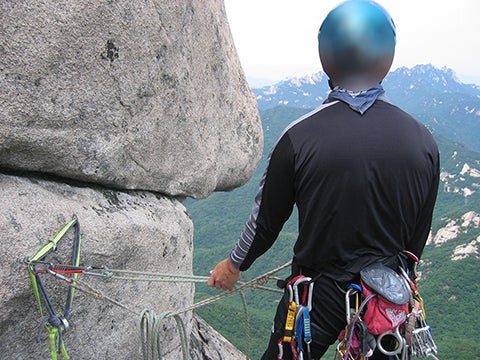Heading out the door? Read this article on the new Outside+ app available now on iOS devices for members! Download the app.
The beauty of this anchor is in the simplicity.—Michael, via email

LESSON
Indeed, Michael. This anchor is simple to a fault. Most climbers use an acronym like SERENE to evaluate multipitch anchors. SRENE stands for Strong, Equalized, Redundant, Efficient, and No Extension. The problem, in this case, is that the acronym assumes you’re using more than one anchor point. This anchor is so simple I’m not sure it qualifies as an anchor at all.
So we’re all on the same page, here’s what I see in this photo: It appears that this climber is belaying a second up with a Munter hitch from one quickdraw clipped to one bolt. The belayer is direct on the “anchor” via another carabiner. None of the carabiners are lockers.
Every single piece of this system depends on one bolt. Bolts are extremely strong, but they do fail on occasion. Sometimes the wrong metal is chosen for the environment. Sometimes they’re installed poorly. Sometimes the rock breaks. This is why we like our anchors to be redundant. There’s another bolt 12 inches away, so there’s no reason not to include it in the anchor. The other major failing is that no locking carabiners were used. Any time lives depend on a single carabiner, it should be a locker or two opposite and opposed carabiners. The belay carabiner especially should always be a locker.
A best practices version of this anchor would look something like this
- A locking carabiner would be clipped to each bolt and locked. (Two opposite and opposed carabiners don’t fit well on one bolt.)
- A cordelette, webbing, or the climbing rope would be clipped to each locking carabiner then tied to form a masterpoint. There are many ways to accomplish this. This method is fairly straight forward. Though that article is written for toprope anchors, the technique is very similar. The equalette and double figure eight methods are also easy and effective.
- Instead of a Munter hitch, which can put twists in the rope, the follower would be belayed with a tube-style belay device in guide mode. The belay device would be attached to the master point with a locking carabiner, and the rope would be attached to the belay device with another locking carabiner. Note that it’s acceptable to belay with a Munter hitch, and it’s a great skill to have in your bag of tricks (here are a few tips), but a belay device makes things easier.
- To put himself direct on the anchor, the belayer would use the anchor shelf to keep everything nice and tidy. Again, he would be attached with a locker or two opposite and opposed non lockers.
- These are all complicated skills and I recommend learning them on the ground with an experienced partner or guide. Keep in mind that this article isn’t comprehensive and merely provides an overview. Some of these techniques have their own limitations and may not be right for every situation. For example, lowering a climber with a belay device in guide mode isn’t as straightforward as it may seem. Do your research before embarking on any multipitch adventures or you may end up in this column (or worse).